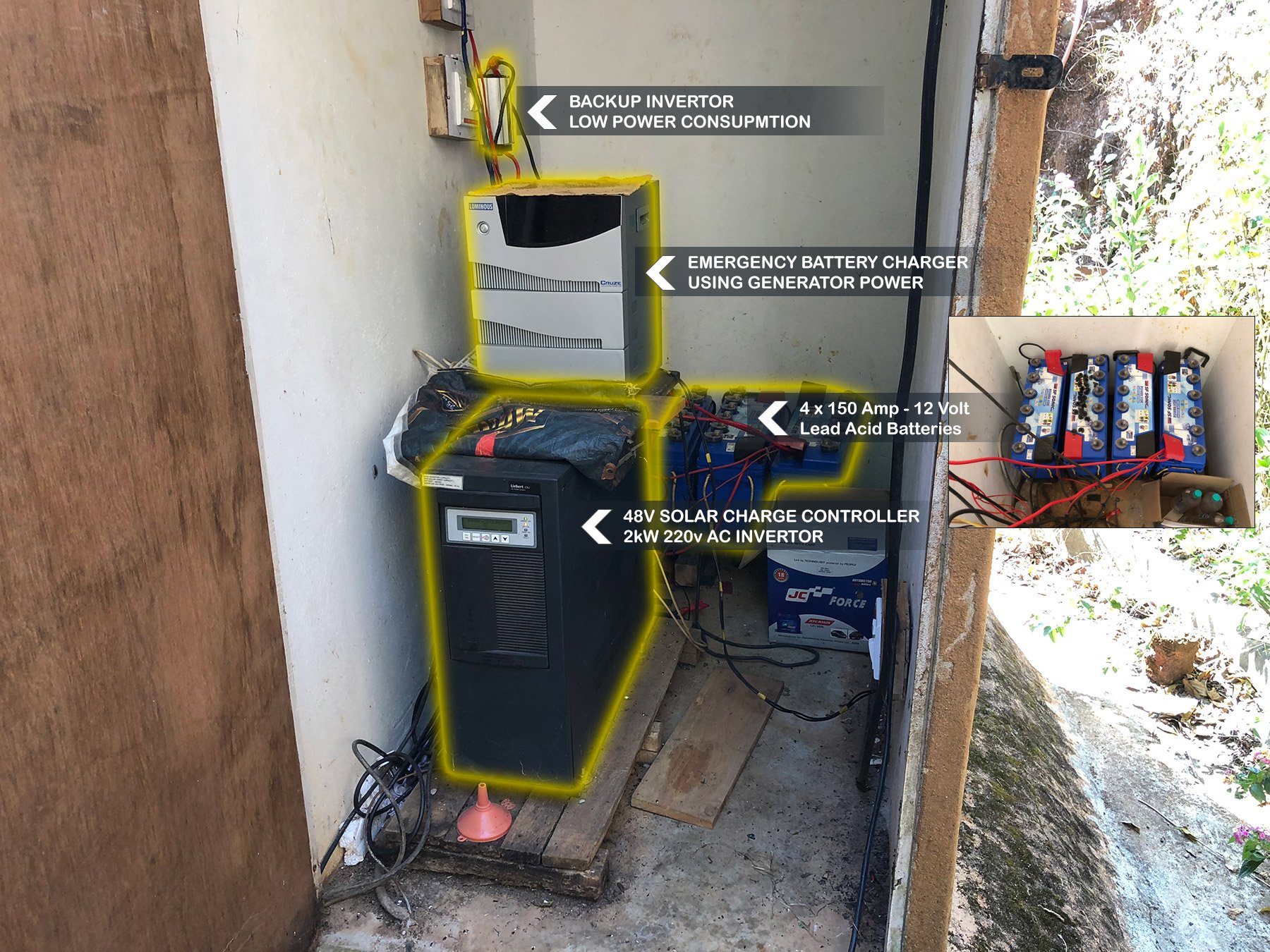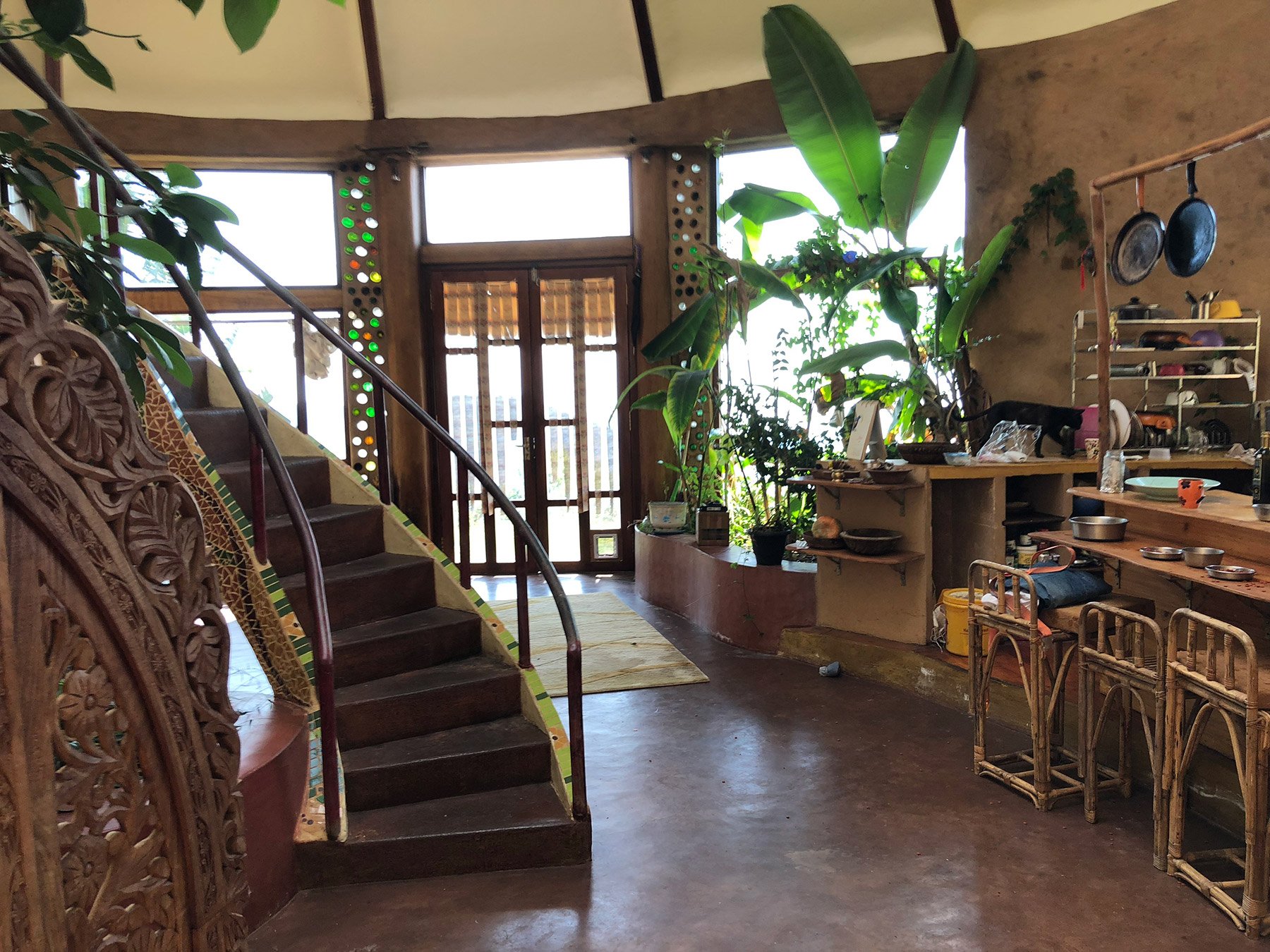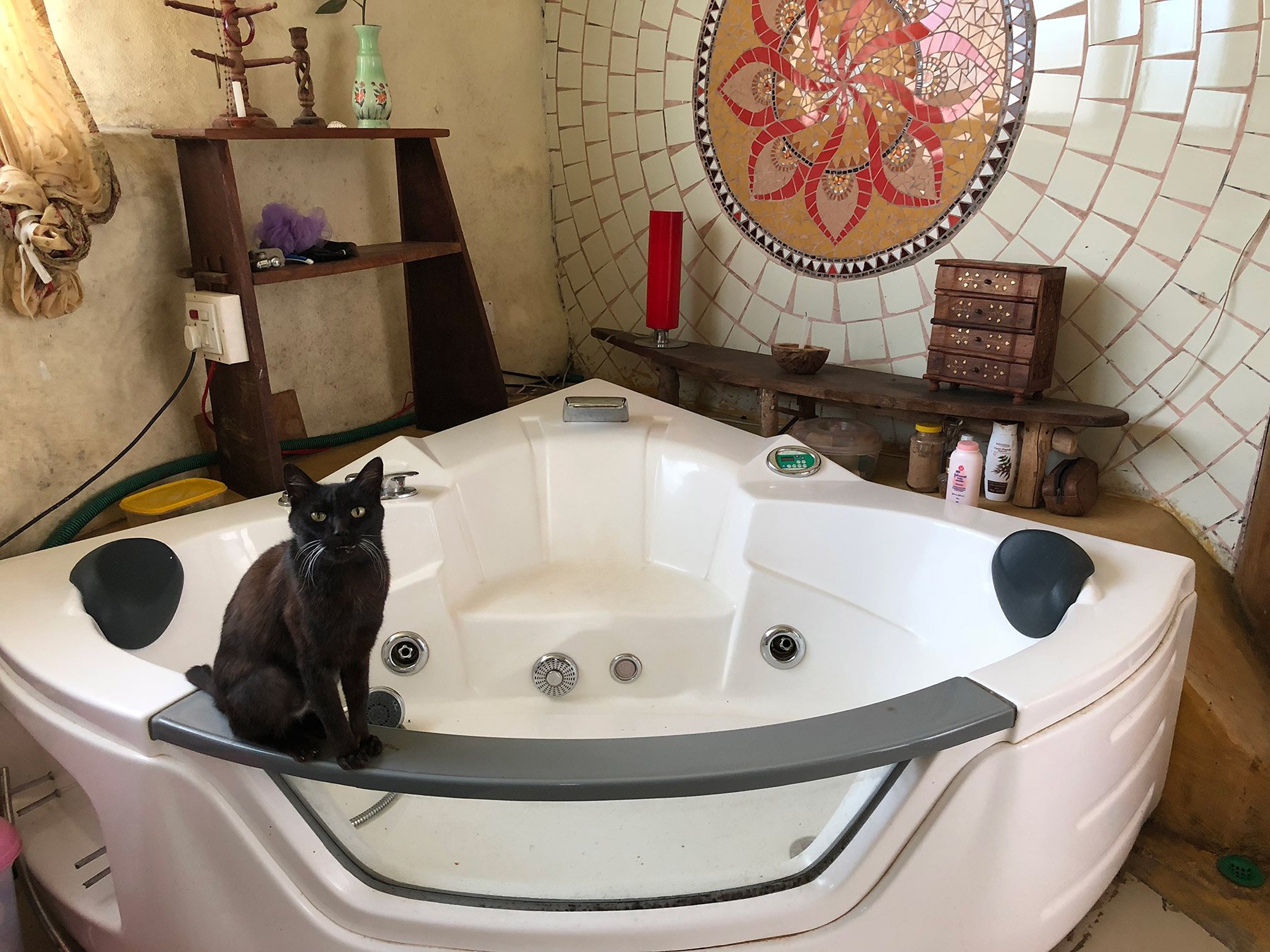
I have been living off-grid for around 12 years now, and am writing this post from Earthship Karuna using power from the sun. Today the sun is shining brightly and that solar power is being instantly converted into electricity for me to use. My whole home is powered by the sun, with excess energy being stored in four big batteries for the night time and cloudy days. It's fair to say that since I live in India, I have one of the most reliable power supplies in the whole country! I almost never have a power cut, and also have some backup options in case there is no sun for weeks on end.
I am writing this post to share with you how solar power works, what components are needed to be able to power your home from the sun, and specifically how Earthship Karuna is powered with a tour of the appliances that I use. I will also explain some of the considerations you will need to make if you are considering changing to solar power, and explain some of the limitations of using solar power
Solar power is an amazing option, and it is only getting better as Solar Photovoltaic Panels are becoming more efficient, and are getting cheaper all the time. Solar Power really shines (excuse the pun) when the home that is is running in is geared toward being off-grid. This means that the house should be built and run to be as energy efficient as possible. An Earthship is the epitome of energy efficiency, and Earthship Karuna is a good example of a home that is quite luxurious with all the mod-cons that we desire from a normal home, but using a tiny fraction of the energy that a conventional home uses. An average home uses around 6 Tonnes of CO2 per year, where as Earthship Karuna produces around 0.7 Tonnes of CO2 which is mainly from cooking.
So, if you are considering going off-grid I hope this post will give you some good information and solid advice about what you can realistically expect from Solar Power, and what changes you may need make in order to be able to make Solar Power work for you.
Earthship Karuna's Solar Photovoltaic Panels
6 x 24Volt Panels (48V Final Voltage) Providing 1,000 Watt/hour (1 kW/h)

These panels have been delivering me power all day every day for 6 years. The only maintenance I have had to deal with is cleaning them with water every few months. They still look about as good as the day I bought them. These panels cost around $600 USD, which is extremely good value considering they will easily last 20 years or more. I have just checked and surprisingly you can buy the same kind of panels in the UK for almost exactly the same price! wOW things ARE getting MUCH cheaper now worldwide! (http://www.buypvdirect.co.uk/PV_Panels).
These panels are oriented to face South, which picks up most of the light of the day from sunrise to sunset. They are also angled slightly toward the sun so maximize the exposure to the sun's rays. This is an ideal scenario, and there are many situations when you cannot get a clear south view, or the desired angle. This is not a deal breaker, but just means you wont get as much power from them, but they will still work, and especially in hot sunny countries! Note that you do not need to live in a very sunny location to be able to get a significant amount of power from solar panels. Germany has a huge amount of Solar power being fed into their grid, and they have long cold cloudy winters.
The six solar panels are wired together and connected inside a junction box. From that box there are just two wires that lead to the Power Systems Room.
The Power Systems Room

The solar photo-voltaic panels are wired in to the Solar Charge Controller. This machine takes care of charing the batteries and ensures that they don't over charge. The solar charge controller will also protect the batteries from going too low in voltage (due to overuse) and switch the power off if necessary. The four batteries in this room are the heart of this power system. The batteries are able to store and deliver power when the sun is not shining and throughout the night.
I have around 900 watts of solar power coming in right now, and am using about 200 watts with my computer running and all other appliances that I need being used. The batteries are full, and I can basically use anything I want all day long without even touching the stored power in the batteries. That includes running my 150 Watt fridge, 400 Watt washing machine, 45Watt Water Filter etc. When the sun is out, its all systems GO!
In this situation I have ONE machine doing two jobs. The inverter is a machine that is often separate from the solar charge controller, and it is the inverter that converts this 48V DC solar power into the normal 100V/220V AC power that you will be familiar with. I depend on the inverter as little as possible since it is quite power consuming, even when left idle, and also because if it breaks I wont be without lights, Internet, and phone charging etc (priorities!). I also have a backup inverter that you can see stuck on the wall. This little box costs about $80 USD and will provide around 300 Watts of power. I use it IF it is very cloudy to conserve power, and also as a backup IF my main machine breaks.
The batteries are the most expensive and high maintenance part of this system. These batteries cost me around $500 in India, and will only last around 5 years until they cannot hold power very well. I could have invested more money in larger deep cycle batteries and then you would likely get 10-20 years out of them, depending on how you treat them. I went with these because they were easy to get locally, and are MUCH cheaper than any deep cycle batteries. Since it is quite easy to kill even deep cycle batteries, I'm happy to spend less and be less concerned about them going bad. The most important maintenance is keeping them topped up with distilled water. If you do that every month you will reduce one common cause of battery damage!
The second most common cause of battery damage is letting the voltage go too low too. If you have a good balance between the number of panels and batteries, you shouldn't take the voltage down below half full very often at all. If the balance is right, you will also get them charged up quickly each day. Provided that you are not drawing too much power, you are likely to do very well with Solar Power.
SO now you have seen the main power systems, you can come inside and check out how I am managing to use a VERY minimal amount of power to live and be very comfortable.
Earthship Karuna, Kodaikkanal, India

Welcome inside! As you can see, this isn't your average looking home. It is made from reclaimed car tyres, dirt, plastic bottles, wood, and a touch of cement. The walls of this house are around 2 feet thick at its base, and they can hold and store a LOT of energy from the sun. The walls of this house are its heating system. I have a fireplace, and use it around once a year. For the rest of the year, this house can keep itself warm with little to no power use. It also has an abundance of natural light, so we don't need any lights on in the day!
Safety First! - Fuse Box

Ok this looks a mess, I KNOW! I just got used to it ;-) Obviously if done nicely you wouldn't see all these wires on the wall. These fuse boxes will trip and protect the power system in the event of a power problem, short circuit etc. The 48V to 12V converter is a very useful little device that will give me 12V DC power all the time. I can use 12V to run all the lights and other devices in the house without needing the inverter. This is more efficient, and means im not SO reliant on the inverter working.
Lights!

Fridge / Freezer

I use my fridge in the summer time, when power is plentiful and my food goes bad very quickly. In the winter my power system can't cope with the demand on this fridge, but my food also doesn't spoil to quickly so there isn't much need for it. If you want to have a fridge year round then there are better options such as a super insulated DC fridge or a larger power system.
Kitchen Appliances

I love my kitchen, and I have everything I need to cook well! I use the slow juicer for most things, except hummus! It uses much less power and is even better at the job. I don't have an oven in my kitchen as I don't bake, so I never got one. If you are running on Solar Power, then an electric oven is just not an option. If you want convenience, you can opt for a gas powered oven which will work well and CAN source naturally produced bio gas if you desire. A good oven can use up 5,000 watts, or 5kW or power! That is the same as 100 apple mac laptops, or 1,500 LED lights! I also don't have a toaster for the same reason, and just grill bread on a frying pan when I want toast. I always heat water on my gas cooker, an electric kettle is just a no no, running at around 2,200 Watts or 2.2 kW!
Clean Filtered Water

The water source for Earthship Karuna is a natural spring that is high above the house in the mountains. This is a perfect situation because I do not need any pumps to bring water in to the house. My water tanks are high enough behind the house that water pressure is Very high for both hot and cold water. I do have a rainwater harvesting system, with a large underground water tank that can store up to 25,000 liters of water. I have never used it as it requires pumps and power, and we are lucky to have enough spring water year round. Nevertheless, this water is not clean enough to drink, mainly due to dirty tanks and old pipes, and so to be sure we have a good reverse osmosis water filter. We use it for all cooking, and cleaning salads etc. We wash dishes with unfiltered water, and have solar hot water available for that. This machine uses just 45 watts of power, and only when it is filling. This is a very small amount of power for bringing reliably clean water to the kitchen. The main issue with reverse osmosis is that there is a lot of reject water that is lost. In Very dry climates you might try a different option, OR at least you would catch and use the reject water to irrigate your plants or even to flush the toilet with!
Washing Machine

Yep, washing machine! No problem on solar. Although this machine does use a lot of power, at 600 Watt max, it isn't used for very long or very often. Therefore I can do a wash most days and not have any problem with power. If it is very cloudy i may wait a day to use it, OR if its urgent i would use the generator to power it.
Jacuzzi!!

Whatt!? yes, an eco friendly jacuzzi. This uses a LOT of power, up to 800 watts, but again since its only on for a few minutes and very rarely we are able to use it when we really want. I normally use it without the jets, and it is filled from solar heated water, piping hot!
Office

This whole office requires about 100 watts maximum. I also have a printer and scanner, which uses 50 watts when being used. By opting for a laptop instead of a desktop we can save 2000% on power use. A good desktop will easy use 1,000 watts or more! These days its all too easy to have many very good office appliances with little to no energy use. This bluetooth speaker sounds GREAT, and is runs for 30 hours on its own battery!
So NOW you have seen how well Solar Power can work when you have the right appliances, working in the right home, built from the ground up to work efficiently and trouble free. If you are considering changing to solar power, the first decisions you should make are what appliances you should replace so that you are running with the least demand on your batteries and power system. I can run the basics, which is lights, Internet, laptop etc at around 50-100 Watts. That is an amazingly low figure and is why solar power can and does work incredibly well in the right situations.
If you have any questions or are considering making a change to Solar please feel free to ask me anything in the comments.. There are a LOT of options and it can be hard to know what is best for your particular situation.
Now time to do the laundry with piping hot solar heated water and free power!
Yes, all this, and NO BILLS TOO! '=)

@ecotrain
Supporting People Who Help
Make The World A Better Place

find previous ecoTrain magazines at @ecoTrain
DRIVER
@eco-alex
CONDUCTOR
@likedeeler
VIPS WHO HAVE DELEGATED STEEM POWER
@omdemian
@kalima
PASSENGERS
@bristena94
@clara-andriessen
@ecoinstant
@hopehuggs
@kiaraantonoviche
@misslasvegas
@mountainjewel
@schoonercreek
@sharoon-yasir
@solarsupermama
@stillgideon
@stillwatersart
@trucklife-family
If you are new to Steemit, love to write, and would like to join the ecoTrain community as an official passenger please email me on steemit.eco.train@gmail.com
** Click Here For More Information on the ecoTrain **


